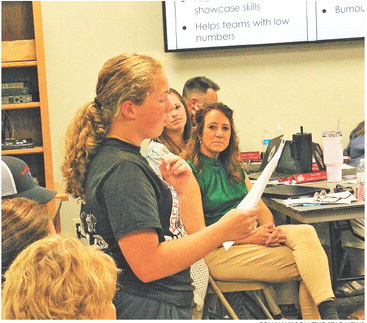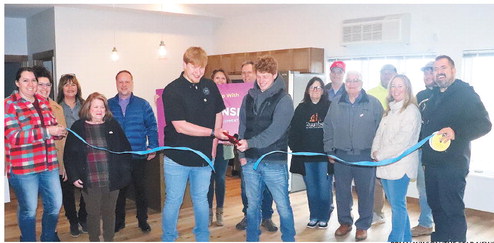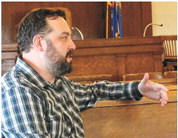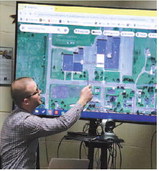Medford gives go-ahead for dual-sport athletes


Students athletes in the Medford School District will be able to be in two sports at the same time during the 20252026 school year.
On Monday night, school board members voted to allow the dual-sport option for students with the conditions they meet all the academic requirements and that a contract is created with agreement between the coaches, students and parents over things such as schedule, attendance at practices and game obligations. Students will be required to declare a primary sport, which will take priority when there are scheduling conflicts.
The decision came after a lengthy, and at times heated, discussion which saw multiple motions and showed sharp philosophical differences between board members.
The issue had initially been raised at the May school board meeting. Bella Lemke, who will be entering 9th grade at Medford Area Senior High School next fall, with the support of her parents Ryan and Jackie Lemke, requested being able to participate in curling and girls hockey in the same season.
According to activities director Ryan Pilgrim, while there have been student athletes who have inquired about it in the past, he said that in all those instances it was found to be unworkable as the process advanced.
At Monday’s meeting, Pilgrim said he reached out to seven nearby school districts and found that five of them have mechanisms in place to allow dual-sport athletes with Rhinelander in the same process of discussing it as Medford.
According to district administrator Laura Lundy, the administration recommendation is that it should be left with the administration to handle with the development of contracts with the parents, coaches and athletes.
Pilgrim said there are sports that are more or less comparable, as well as positions on those sports teams. For example someone from the soccer team being the kicker on the football team. However, being on football and cross country at the same time could cause too many conflicts. Pilgrim said that curling and hockey are among the combinations with a greater chance of success.
“I think there are some opportunities where I think it could work,” he said.
Bella Lemke addressed the school board at Monday’s meeting and asked them to allow her to have the opportunity to go out for the two sports. She said she is confident she has the ability to succeed.
According to Pilgrim one of the reasons schools look at allowing dual-sport athletes is to help with numbers in programs. The district has guidelines in place that were adopted by the board, although not part of the formal policy, which would set levels at which sports programs could be cut. Generally if the participation levels are below 12 students athletes, the programs could face cuts. Curling has fallen below those numbers in recent years, while at the same time fielding competitive teams.
During the public comment period at the board meeting, resident Kate Metz and Bill Grunewald spoke in support of maintaining curling as a high school sport, noting the lifelong nature of the sport and the decades of success the district has seen with high school curling teams. Since first becoming a high school sport in Medford in the 1950s, the team has brought home 13 state titles including five state titles for the girls and eight for the boys. “Pick another sport that is even close to that,” Grunewald said. Beyond that he noted that curling is truly a lifelong sport built on camaraderie and respect.
Board president Dave Fleegel said the district had no intention to eliminate high school curling, to which board member Kurt Werner replied noting that the thresholds for eliminating sports were brought up for a reason.
On the question of if the district should allow dualsport athletes, there was sharp disagreement among board members.
Fleegel noted his opposition to allowing the request was due in part to exceptions that would be made to allow dual-sport students to miss practices, while at the same time coaches are not willing to make those same sorts of concessions to students who have work obligations.
“I don’t see a difference between two sports or sports and job,” Fleegel said, citing his own experience as someone who employs high school students. He noted it is common for coaches to change practices at the last minute or for games to be rescheduled.
Fleegel said he would have no problem with allowing it in situations where they would need another player to be able to compete at state. He noted his daughter filled in for the girls curling team in order to have the required four players to compete at state.
“I think we are losing our way on sports,” said board member Brian Hallgren. He said he was a flat no on that. “It is not our job to recruit kids for the curling team,” Hallgren said.
Hallgren made the first motion of the discussion saying he was willing to specifically allow Bella Lemke’s request for the coming school year. He noted that it would be only for her freshman year unless other board action was taken in the future. He said it would be one student, one year and one time.
“It makes no sense to me,” Werner said, stating he could not believe the board was even having this discussion. He asked how board members could tell parents what was best for their children. “These are going to be one-offs,” Werner said. “You aren’t going to have 50 kids doing dual sports.”
Werner said if they are going to allow it for one student they should allow it for any student. He attempted to offer an amendment to broaden allowing all students, but objections were raised that this changed the intent of the motion. It was ultimately decided to vote on the motion and if that failed there would be a chance to make another motion.
“Why limit kids?” said board member Heidi Haynes. She said allowing dual sports would increase opportunities for students and objected to the idea of limiting those opportunities.
Board member Don Everhard said initially he was opposed to the idea, but noted that people have the right to decide how they want to live their life and the choices they want to make.
“Their job is to be a student,” said board member John Zuleger raising concerns about the impact on students’ grades. Werner countered that they would have to meet grade requirements to participate in one sport and if they fell behind they would not be able to compete at all.
“We are on the education board, not the sports board,” Zuleger said. “I don’t think you will see students excel in academics,” he said.
Board member Steve Deml objected to the idea of making a rule for one student. “We are supposed to be general oversight,” he said. He said he felt it would be the board making choices for employees that they can make on their own referring to Pilgrim.
Parent Ryan Lemke suggested making a checklist to make sure the coaches agree and that the student athlete understands they are not necessarily going to play as much. It was noted that coaches already have to deal with other coaches in independent club sports and that it should be easier for them to deal with coaches within their own school system.
On the first vote, the motions failed. Board member John Zuleger made a motion with Hallgren seconding it to not allow dual sports in any shape or form for anyone.
Zuleger said he appreciates that it happens in other districts, but said, “It is entirely different to allow it under our watch.” That motion also failed.
Werner made his motion to allow it for all students who wished to do it on a trial basis for the 2025-2026 school year with a review by the board next year and the contract language based on that used by other districts.
Zuleger questioned the academic standards suggesting they should be higher for dual-sport athletes.
Everhard disagreed saying he felt that would be punishing students who want to do more.
Hallgren noted that part of doing anything in life is having to make choices. “It is about teaching some lessons,” he said.
“If five other districts can make it work, why can’t we try it?” Haynes asked.
In the end Fleegel was the flip vote to give the 5-3 majority needed to pass the motion. Board member Corey Dassow was absent from the meeting leaving eight voting members.
In other business board members:
• Approved changes to the district’s athletic code of conduct for name image likeness rules to match the WIAA rules and to clean up other language regarding administration and regarding absences from school to include restrictions on participation following excused absences for any reason, not just for illnesses. The board specifically opposed adding a “level zero” code violation and language that would give administration the ability to increase or decrease a penalty in the code violation. Pilgrim had asked for the changes to give greater flexibility in assigning punishment to ensure that it is commensurate with the level of offense. He noted that depending on the timing of a violation, a lower level violation could be season-ending for a student if it happened near playoffs.
• Received the semi-annual bullying report from each of the schools in the district. Building staff also updated the board on behavioral issues and how they are being addressed. At the middle school level, there has been a focus on restorative justice efforts rather than simply punishment to give students a greater awareness of the impact of their actions. At the high school level assistant principal Andy Guden noted that there were drops in behavior concerns across the board, something he attributes directly to the decision made last summer to ban cellphone use by students in the school.
• Approved increasing the pay for substitute teachers. Finance director Audra Brooks recommended the changes after surveying area school districts and finding that Medford was lagging behind. She noted that finding substitute teachers is an ongoing challenge. While the district benefitted from having a person in-house to serve as a sub as needed for the middle school this year with the need to pay benefits it is cost prohibitive to continue to do that. The changes adopted by the board goes from $130 per day to $150 per day for short term substitute teachers. Long term substitute teachers will go from $193.79 per day to $200 per day and retired teachers will go from $148 per day to $170 per day. Brooks included about $10,000 additional for substitutes teacher pay in next year’s proposed budget. “You can’t afford to do it, and you can’t afford not to,” Fleegel said during the finance meeting before the regular school board meeting. It has been at least six years since the substitute teacher pay was updated.
• Approved setting the school meal prices the same as they were this year. Brooks noted the district’s food service fund balance remains healthy and no increase was needed. Fleegel praised keeping the meal prices the same noting that unless they were forced to do so by the federal government, the district would not increase the prices.
• Received a construction update. Work is expected to begin later this summer and continue through the school year for the relocation of the utility lines. It was noted that they are cleaning up many things with utility, electrical and data connections to the high school in preparation of the work to take place. Access between the tech ed building and the main high school will be rerouted next fall for students to exit out the east side of the building rather than from the north doors. A 25-foot hole will be dug to access utilities in the area between the two buildings. Also, the road on the east side of the building by the tennis courts will be closed through the construction project.
• Received the annual School Health Services report from district nurse Mindy Schwarz. The nurses in all the school buildings saw a combined 19,626 health room visits over the year. There are 743 students in the district with noted health conditions and another 108 students with health plans. Schwarz highlighted the work done by the school nurses and the various programs they took part in over the year to provide health services to students in the school.
• Received word that Brooks will become the president-elect of the Wisconsin Association of School Business Officials on July 1. This is the statewide organization for those who work on the business side of school operations in the state. This is part of a three-year leadership track and she will move to president next year and the following year be past president. She said one of her missions is to represent rural schools in interactions with the state. “We are all the same, but we are very different in how we operate,” she said, noting the different between small rural schools and larger districts in the southern part of the state.






